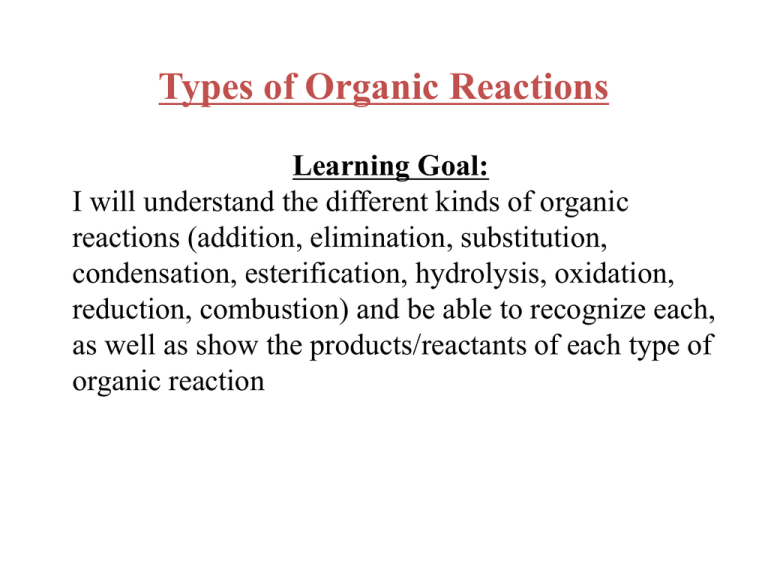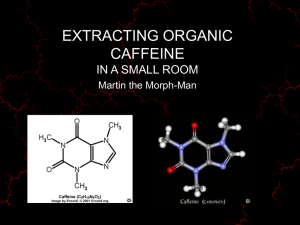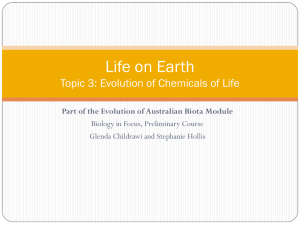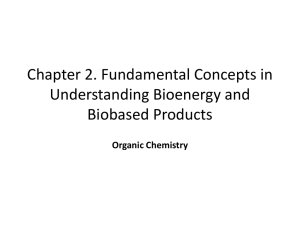Types of Organic Reactions
advertisement

UNIT 1 Chapter 2: Reactions of Organic Compounds Section 2.1 Types of Organic Reactions Learning Goal: I will understand the different kinds of organic reactions (addition, elimination, substitution, condensation, esterification, hydrolysis, oxidation, reduction, combustion) and be able to recognize each, as well as show the products/reactants of each type of organic reaction UNIT 1 Chapter 2: Reactions of Organic Compounds Summary of Organic Reactions Important types of organic reactions: • addition • elimination • substitution • condensation • esterification • hydrolysis • oxidation • reduction • combustion Section 2.1 UNIT 1 Chapter 2: Reactions of Organic Compounds Section 2.1 Recap: Addition Reactions • • • • Reactions between an alkene or alkyne and a small molecule (HOH, H2, HX, X2) Atoms of a small molecule are added to carbons of a double or triple bond Reactions of alkynes can produce alkenes or alkanes Constitutional isomers may form Carbon atoms of the multiple bond have more atoms bonded to them in the product. UNIT 1 Chapter 2: Reactions of Organic Compounds Section 2.1 LEARNING CHECK #1 Show how constitutional isomers can form from the following reaction. Answer on the next slide UNIT 1 Chapter 2: Reactions of Organic Compounds LEARNING CHECK #1: ANSWER The chlorine atoms can be added to either carbon 2 or 3 in this addition reaction. Section 2.1 UNIT 1 Chapter 2: Reactions of Organic Compounds Section 2.1 Addition Reactions (cont’d) One constitutional isomer will predominate. To predict the major product: Markovnikov’s rule: The hydrogen atom of the small molecule will attach to the carbon atom of the double bond that is bonded to the most hydrogens. The 2-chloropropane isomer will be the major product. UNIT 1 Chapter 2: Reactions of Organic Compounds Section 2.1 Elimination Reactions • • • Two atoms bonded to carbon atoms of an organic molecule are removed and a double bond forms The double bond forms between the carbon atoms that have had the atoms removed Elimination reaction can be thought of as the reverse of an addition reaction Carbons of the organic product are bonded to fewer atoms than carbons of the reactant. UNIT 1 Chapter 2: Reactions of Organic Compounds Section 2.1 LEARNING CHECK #2 Draw the product of the following elimination reaction. Answer on the next slide UNIT 1 Chapter 2: Reactions of Organic Compounds LEARNING CHECK #2: ANSWER The product formed is: Section 2.1 UNIT 1 Chapter 2: Reactions of Organic Compounds Section 2.1 Elimination Reactions (cont’d) What if an asymmetric molecule undergoes elimination? General rule: The hydrogen atom is more likely to be removed from the carbon atom with the most C-C bonds. UNIT 1 Chapter 2: Reactions of Organic Compounds Section 2.1 Substitution Reactions • • • Reaction in which a hydrogen or functional group has been replaced by another functional group Two compounds react to form two different compounds The same number of atoms are bonded to the carbon atoms of the reactants and products Two compounds are converted to two new compounds. UNIT 1 Chapter 2: Reactions of Organic Compounds Section 2.1 LEARNING CHECK # 3 Draw the products of the following substitution reaction. Answer on the next slide UNIT 1 Chapter 2: Reactions of Organic Compounds LEARNING CHECK # 3: ANSWER The products formed are: Section 2.1 UNIT 1 Chapter 2: Reactions of Organic Compounds Section 2.1 Condensation Reactions • • • • Two molecules combine to produce a larger organic molecule and another much smaller molecule Water is often the smaller molecule formed Large biomolecules (DNA, fats, carbohydrates, protein) are formed through this type of reaction Production of amides and esters are examples A condensation reaction between a carboxylic acid and an amine produces an amide. UNIT 1 Chapter 2: Reactions of Organic Compounds Section 2.1 Esterification Reactions (A type of condensation reaction) • • These are a type of condensation reaction A carboxylic acid and an alcohol react to produce an ester and water In what way(s) is an esterification reaction like a condensation reaction? An esterification reaction is between a carboxylic acid and an alcohol. UNIT 1 Chapter 2: Reactions of Organic Compounds Section 2.1 Hydrolysis Reactions • • • A molecule is broken apart through the addition of a water molecule (HOH) The –OH is added to one side of a bond, and the H is added to the other side of the bond They are the reverse of condensation reactions In hydrolysis reactions, molecules are broken apart using water as a reactant. Hydrolysis Reactions are the Reverse of a Condensation Reaction UNIT 1 Chapter 2: Reactions of Organic Compounds LEARNING CHECK #4 Section 2.1 What are the products of the following reaction? What type of reaction is this? Answer on the next slide UNIT 1 Chapter 2: Reactions of Organic Compounds LEARNING CHECK #4: ANSWER This is an esterification reaction. The products are: Section 2.1 LEARNING CHECK #5 The hydrolysis reaction with water is so slow that must be catalysed with dilute acid, so the ester is heated with a dilute acid like dilute hydrochloric acid or dilute sulphuric acid. Show/name the products of hydrolysing ethyl ethanoate: UNIT 1 Chapter 2: Reactions of Organic Compounds Section 2.1 Oxidation Reactions • In organic chemistry, the term refers to carbon atoms of the organic reactant • forming more bonds to oxygen atoms, or • forming fewer bonds to hydrogen atoms • Common oxidizing agents, [O], are KMnO4 and K2Cr2O7 Compare the number of C-H and C-O bonds in the reactant and product. UNIT 1 Chapter 2: Reactions of Organic Compounds Section 2.1 Reduction Reactions • In organic chemistry, the term refers to carbon atoms of the organic reactant • forming fewer bonds to oxygen atoms, or • forming more bonds to hydrogen atoms • Common reducing agents, [H], are LiAlH4 and H2/Pt Compare the number of C-H and C-O bonds in the reactant and product. UNIT 1 Chapter 2: Reactions of Organic Compounds Section 2.1 LEARNING CHECK #6 What is the product of the following reaction? Is this an oxidation or reduction reaction? + [H] Answer on the next slide UNIT 1 Chapter 2: Reactions of Organic Compounds LEARNING CHECK #6: ANSWER The reaction is a reduction of propanone (acetone) to produce propan-2-ol (isopropanol). There are fewer bonds to O, and more bonds toH Section 2.1 UNIT 1 Chapter 2: Reactions of Organic Compounds Section 2.1 Combustion Reactions • • • A compound reacts with oxygen to produce oxides of the component elements The products of the complete combustion of a hydrocarbon are carbon dioxide and water If O2 is insufficient, incomplete combustion occurs UNIT 1 Chapter 2: Reactions of Organic Compounds Organic Reactions Summary Section 2.1 UNIT 1 Chapter 2: Reactions of Organic Compounds Section 2.1 HOW DID WE DO? Learning Goal: I will understand the different kinds of organic reactions (addition, elimination, substitution, condensation, esterification, hydrolysis, oxidation, reduction, combustion) and be able to recognize each, as well as show the products/reactants of each type of organic reaction









